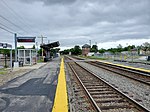Francis W. Parker Charter Essential School

The Francis W. Parker Charter Essential School (usually referred to as the Parker Charter School by the public, or simply Parker by students) is a public charter school in Devens, Massachusetts, United States that serves students in grades 7 to 12. It was established in 1995 under the Massachusetts Education Reform Act of 1993, and serves about 400 students from 40 surrounding towns in north central Massachusetts, including Ayer, Shirley, Littleton, Leominster, Lunenburg, and Worcester. As a member of the Coalition of Essential Schools, a leading organization for education reform, Parker is known for its nontraditional educational philosophy. The school takes its name from Francis Wayland Parker, a 19th-century pioneer of the progressive school movement.
Excerpt from the Wikipedia article Francis W. Parker Charter Essential School (License: CC BY-SA 3.0, Authors, Images).Francis W. Parker Charter Essential School
Antietam Street,
Geographical coordinates (GPS) Address Phone number Website External links Nearby Places Show on map
Geographical coordinates (GPS)
| Latitude | Longitude |
|---|---|
| N 42.548773 ° | E -71.606323 ° |
Address
Francis W. Parker Charter Essential School
Antietam Street 49
01434
Massachusetts, United States
Open on Google Maps










